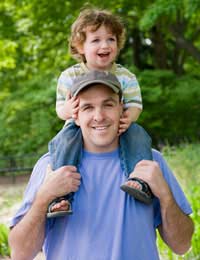Take a Nature Observation Walk

Small children can get bored easily, so combining a walk outdoors with something that's both fun and educational is sure to be a winner. Nature observation walks can be fantastic learning experiences for toddlers and even babies can enjoy the ride, provided they have plenty to look at and keep them busy along the way.
Planning the Walk Itself
It's best to plan a short walk of an hour or less, depending on your child's age and stamina level. The easiest way to get them interested and excited is to involve them in every aspect of the planning. Depending on where you plan to go, that can mean packing a backpack with various items, plotting a route and talking beforehand about what to look out for.Route Planning
To plan a route, get out some paper and crayons and make a rudimentary map. An example is: to the playground, around the corner, past the newsagent's, through the tiny field and then back. Draw images along the map they can follow easily that represent certain landmarks, and let them cross off where they have been.Next, decide what you hope to see on your walk. Would you like to hunt for three ladybirds, two spiders and another insect, for example, or do you hope to find six leaves, a pinecone and three shiny stones? Keep your child's interest in mind and get a small bag ready where they can collect their treasures.
Necessary Supplies
Next, pack the backpack. You may want to include a water bottle and a small snack, such as a few biscuits and an apple. If it's a sunny day a bottle of suncream may be a good idea, as well as a sunhat and small cloth. Your children might also want to take some treasures of their own, such as a compass or cuddly friend to accompany them, and a bucket or sack for their nature “collection”.On the Look-Out
Once you begin your walk, don't limit yourself to the big picture. Instead of just pointing out a tree as a single object, observe more carefully. Upon closer inspection, you may notice a spiderweb, a bird building a nest, a cluster of unusual leaves or bark or even a wasp's nest. If your curiosity is piqued – and that of your child's – this could lead to more in-depth observations, and could even mean future purchases of field guides, insect bibles and other publications of interest.Listen also to the sounds that nature makes. The world is not only a visual one, it supplies us with a wealth of sounds, smells and physical sensations as well. Involve your child in looking under the surface and actually feeling what the world can provide. Sensory awareness is a wonderful thing.
Here are some things to look out for on your walk:
- Squirrels and other rodents
- Insects, making sure to include your child's favourites
- Unusual stones or rocks
- Leaves that are brightly-coloured, a funny shape or unique in some other way
- Ant colonies or other animal/insect mounds, hills or homes
- Trees that are different, including bark, trunks, shape etc
Name It
Children love games, so make a game of it. Ask them to name objects they observe, or quiz them about what they encounter on the walk. The questions can be as simple as “Do you see something brown?” to something more complex such as “How many different plant types do you see?” or “Do you see a bird with a blue wing and one with a black wing?”Most kids this age also love to count, so you can simply have them keep track of the number of things they see en route outdoors, such as big trees, cows, blades of grass for the more serious, etc. You can also encourage them to start their own collection of items that occur in nature, having them carry a bucket for special rocks or leaves.
Letting your children know which things are okay to pick (wildflowers) and which aren't (your next-door neighbour's prize roses) is also an important lesson for them to learn.
Back in Civilisation
Once you return home, the walk doesn't have to end. Depending on your child's age, he or she may enjoy drawing a picture of what they saw on the walk, making a scrapbook that involves gluing down sticks and leaves, or even carrying out more research about what they have seen.Nature walks can be interesting and enjoyable. Just because you don't own a little place in the country doesn't mean you have to limit yourself to walks only on special holidays. Visit your local park, the woods or even a corner of your neighbour's back garden (with their permission). The most important rule is: have fun!


Re: Board Games to Keep Boredom at Bay
Board games, at least the good ones not based on YV shows, do require some critical thinking and can help with expressing…
Re: Cheap Entertainment: Libraries and Playgrounds
Kids can easily become bored by museums and galleries - not just young ones, but teens, too. Although these…
Re: Board Games to Keep Boredom at Bay
There are board games for all different ages, and some new ones, like Carcassone, that have quickly becomes classics. You…
Re: Summer Library Reading Programmes
I like a library reading program me. I am now doing a research on a library reading program me
Re: Great Activities for a Rainy Day
Thank you for this article which has some great ideas. With three children and the summer holidays approaching, I am always…